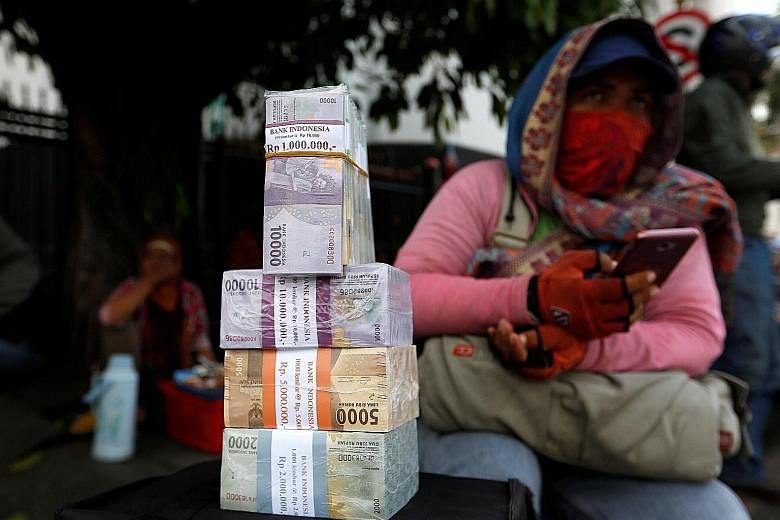For most of the 12 years that Mr Arif Zamron, 46, owned his one-third hectare plot of cocoa in East Java, it earned him on average $11,000 a year in a country where incomes for many can be less than half of that.
But spot prices for cocoa per kilo have ticked up in line with demand for chocolate at home and abroad.
Add to that a resurgent US dollar - the currency the crop trades in - and Mr Arif stands to make about 30 per cent more this year.
"Right now the cocoa business is good," said Mr Arif.
"The domestic market is also expanding because there is more processing here. We've had higher prices but the rising dollar helps."
Regional currencies were gutted during the Asian financial crisis in 1997, but many here are surprisingly sanguine - the falling Indonesian rupiah or Filipino peso is, so far, not causing significant concern.
Part of the reason has to do with healthier economies that are less dependent on debt, and central banks with firepower to protect their currencies.
"I have 800 members and not one of them has voiced any concern about the peso," said Mr Ebb Hinchliffe, executive director of the American Chamber of Commerce in Manila. "This region has seen its fair share of volatility and the veterans know when to just ride it out."
Businesses have been scrambling to reorganise and trim costs rather than pass them along to consumers.
Mr Adhi Lukman, chairman of the Indonesian Food and Beverage Association (GAPMMI), said the rising US dollar has a "big impact" on the food industry, which imports much of its ingredients. An 8 per cent decline in the rupiah relative to the US dollar adds as much as 6 per cent to operating costs, he said.
Mr Lukman, who is also director of PT Niramas Utama, which makes fruit jellies, said companies like his can cope by switching ingredients, reconfiguring packaging and using automation. "We request the government to keep the exchange rate stable around 14,000 to 14,500," he said on behalf of GAPMMI.
"Anything lower than 14,000 hurts the competitiveness of the Indonesian industry."
The rupiah has lost nearly 8 per cent of its value against the US dollar since the beginning of the year. One US dollar recently bought 14,600 rupiah compared with 11,200 at the beginning of the year. This month, the Bank of Indonesia (BI), the country's central bank, hiked interest rates for the fourth time since May to 5.5 per cent, following the Turkish lira sell-off.
At 3 per cent of the country's gross domestic product (GDP), Indonesia's high current account deficit, as well as high proportion of foreign ownership of government debt, makes the country vulnerable, said Mr Harry Su, head of equity capital markets at Samuel International.
With the United States Federal Reserve hiking interest rates, BI will almost certainly need to raise rates again this year, he added.
Still, Indonesia registered a healthy GDP growth of 5.3 per cent in the last quarter, and its foreign exchange reserves, though shrinking, are 10 times the level shortly after the Asian financial crisis, suggesting the government can manage the currency for now.
Even so, the central bank has little room for error, Mr Su said.
"BI will need to follow the Fed closely. There will be two more rounds of tightening and BI will need to follow that."
In the Philippines, the mood is more wait-and-see. The peso has slumped 6.7 per cent so far this year, after government data showed the country ran a US$1.2 billion (S$1.6 billion) current account deficit during the first three months of the year. This follows a surplus during the last quarter last year.
Mr Luis Limlingan, head of sales at Regina Capital Development in Manila, urged calm. One US dollar has more or less bought 53 or 53.5 pesos since May, and there is little sign it may surge to 56 - the record exchange rate set in 2005.
The country's deficit was caused by an influx of equipment linked to its infrastructure building programme. Mr Limlingan said the peso will likely trade between 52 and 53 to the dollar by the year end. "It's a significant sell-off indeed," he said of the peso versus the US dollar. "But not to an alarming extent."
Other currencies have been hit hard as the US ratchets up tariffs on Turkey, triggering a sell-off of emerging-market currencies. The Turkish lira has lost more than a third of its value against the US dollar since the beginning of the year.
By contrast, the Malaysian ringgit has made back most of what it has lost this year and is just a little more than 1 per cent lower than where it started the year. The Thai baht is roughly level, pegging where it was in January.
Thailand's 10 per cent current account surplus, coupled with a wave of holidaymakers, means it has enough foreign exchange to pay for 10 months of imports. This has helped shield it from the sell-off, said Bangkok-based Mr Naris Sathapholdeja, head of analytics at TMB Bank.
The country's central bank has kept the benchmark policy rate at 1.5 per cent since 2015, after years of slowly easing monetary policy.
But even Thailand will need to yield to the economic headwinds as the Fed raises rates and US tax cuts prompt companies to relocate earnings back home. The US government's Bureau of Economic Analysis said in June that companies have moved more than US$300 billion in profits back to the United States.
"Thailand has been a laggard when it comes to rate hikes," Mr Sathapholdeja said. "But the market will force Thailand to follow suit."


